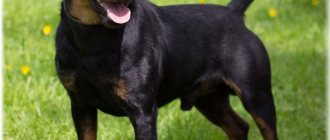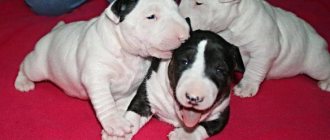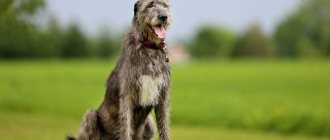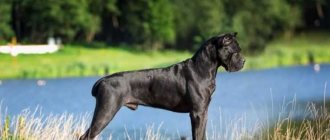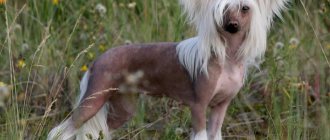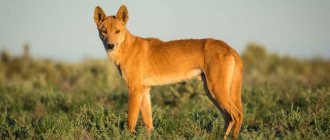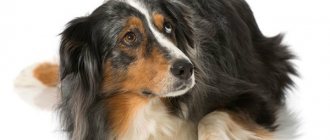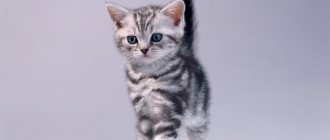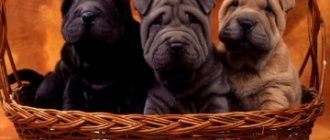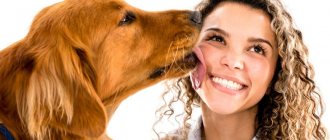The Peruvian Hairless Dog is an ancient, primitive breed that existed long before the Inca civilization. Presumably it appeared somewhere between the 3rd century. BC. and IV century. AD Peruvian dogs are hairless and woolly; in addition, the breed has three height varieties. By nature, they are calm and balanced, devoted to their family and distrustful of strangers. Other names for the breed: Peruvian Orchid, Inca Hairless Dog, Viringo, Calato.
Brief characteristics of the dog
- Other possible names: viringo, Perro sin Pelo del Peru, calato, hairless dog of the Incas.
- Adult height: toy 25-40 cm, medium 41-50 cm, large 51-60 cm.
- Weight: 4-30 kg, depending on height.
- Characteristic color: any solid color and in different combinations.
- Hair length: completely absent, a small amount is allowed on the head and tip of the tail.
- Life expectancy: 12-15 years.
- Advantages of the breed: calm, vigilant, intelligent, affectionate.
- Difficulties of the breed: willful, jealous, does not tolerate heat and cold.
- Average price: from $1000.
Hairless Peruvian dog: description of the breed
Currently, hairless Peruvian orchids are used exclusively as companion dogs, pets and most devoted friends.
Appearance
The physique of Peruvian hairless dogs is very harmonious and elegant, they successfully combine grace and sophistication with strength and speed, and there is not the slightest hint of massiveness or coarseness in their entire appearance . The general format is almost square (body length is equal to height at the withers); in females it is slightly more stretched out. The body is of medium build with a straight or slightly convex muscular back and a toned, tucked belly. Contrary to their name, Peruvians are not always completely naked. There is also a second variety, the body of which is completely covered with hair. It is also recognized as a standard.
Peruvian women are built very harmoniously
Standard Requirements:
- Peruvian dogs come in three sizes: large: height at the withers - 51-65 cm, body weight - 12-30 kg;
- medium: height at withers - 41–50 cm, body weight – 8–12 kg;
- small: height at withers – 25–40 cm, body weight – 4–8 kg.
The Inca orchid's stride is somewhat short, making its gait appear mincing, but the overall gait is fast, flexible and soft.
Almost any skin color is allowed: all shades of solid (preferably) black and grey, blue, dark brown and white. On a plain background there may be pink or white markings of varying sizes on any part of the body. But the ratio of spots should be no more than a third of the entire body.
Spotted Peruvians look the most impressive
It is no secret that the Peruvian hairless dog is called the Peruvian hairless orchid of the Incas. And they received this name for their spotted color, which in many countries is called “orchid”.
Excerpt from comments to standard No. 310 dated August 13, 2013.
In hairless varieties, some hair remains on the head (crest), legs and tail . Single hairs on the back are allowed. The short, sparse and soft coat should lie close to the body and can be of any color and in any combination. The coat of woolly individuals can be very different (straight and curly). Preference is given to short-haired dogs with smooth and close-lying hair. Any color is acceptable.
I saw a naked dog at one of the dog shows. I can’t say exactly what breed it was (Mexican or Peruvian), but the animal looked very unusual and colorful. The spots on the skin are a soft pink shade and really evoke an association with an orchid.
Character and psyche
Peruvian hairless dogs are distinguished by equanimity, self-esteem and a certain skepticism towards everything around them. Understanding their exclusivity, they can afford to be capricious. But these smart animals know their limits; they easily adapt to new conditions and any lifestyle of their owners. They will be equally happy to keep company on a morning jog, while watching an interesting movie while lying on the couch, or on a hiking trip. They won’t give up shopping either.
A devoted and extremely affectionate Peruvian woman tries not to stray far from her owners, constantly keeping them in sight . She always perceives strangers with wariness and distrust, and cannot stand it when they touch her. Even if she allows you to do this, she will make it clear with all her gloomy appearance that it does not give her any pleasure. It is extremely rare to be aggressive, but sometimes it can growl in warning or even bite a stranger who touches it without permission. Dislike of tactile contact is a breed characteristic of these hairless dogs.
Hairless dogs are good guards
Peruvian corydalis are also good guards; their sense of territory is very well developed. The preserved hunting instinct makes dogs rush after cats and other small animals. Although they perceive their cats and other pets quite adequately and get along well with them. They treat children tolerantly, but they will never allow themselves to be squeezed. This breed is more suitable for families leading a moderately active lifestyle, in which the children have grown a little.
It should be noted that Inca orchids can have different characters. Large individuals are more self-sufficient, while small ones are soft and affectionate. Naked Peruvian women are somewhat more capricious and capricious than woolly ones.
Disadvantages and disqualifying defects of the breed
The following are considered defects:
- pincer bite;
- dewclaws (must be removed);
- excess pigment spots (more than 1/3 of the body area);
- not erect ears.
Disqualifying defects include:
- serious deviations from the norm in physical development or behavior;
- problems with the jaws (misalignment, underbite, overshot);
- incomplete dentition in woolly individuals;
- ears cropped or drooping;
- different colored eyes (heterochromia);
- the tail is short, docked or completely absent;
- tongue constantly hanging from the slightly open mouth (paralysis);
- severe deviations from height (below 25 cm and above 65 cm);
- cryptorchidism;
- albinism;
- insufficiently pigmented nose (pale);
- aggressiveness or cowardice, excessive timidity.
La Perm
This cat breed accidentally appeared in France. When one almost bald cat was born in the next litter of an ordinary cat, the owners were scared, but then the cat grew curly hair without undercoat. So, as a result of a strange mutation, a new breed was born. If you suffer from fur allergies, this cat is a great choice as its fur is hypoallergenic.
Mexican Hairless Dog Xoloitzcuintle
The ancestors of modern representatives of the breed were bred more than 3 thousand years ago by the Aztec and Mayan tribes in Central America.
The dogs received the name Xoloitzcuintle from the name of the native god Xolotl. Then they were cult animals and took part in ritual burials. Hairless dogs were killed and buried along with their deceased owners.
The Xoloitzcuintle breed has been formed over centuries through natural selection.
Mexican hairless dogs more than once found themselves on the verge of complete extinction, until in the 50s of the 20th century, cynologists in Mexico and Great Britain approved a revival program. In 1956, Xolos were registered in their homeland, and they became known in other countries.
In Mexico, the Xoloitzcuintle has become a national treasure. There, calm, peaceful animals are attracted to work in nursing homes and hospices. After tactile contact with the skin of dogs, pain in muscles and joints subsides, and gastrointestinal colic is alleviated.
Description
Xoloitzcuintles are well-proportioned, muscular, energetic animals with a high, graceful neck and large, upright ears.
The thick, elastic skin of the Xolo is not afraid of bush branches and insect bites.
Within the breed, 3 types of dogs were formed:
- Miniature ones weigh up to 6 kg and grow up to 25 – 35 cm.
- Medium - with a body weight of 7 - 15 kg, height at withers 36 - 45 cm.
- Standard – weight 16 – 35, height 46 – 60 cm.
In one litter, puppies are born hairless and covered with short, smooth hair. In hairless animals, islands of hair sometimes cover the head, paws, and the top of the tail. Since 2007, both branches are recognized as equal, but two woolly individuals are not mated to each other.
Xolo puppies are hairless and have fur.
The Xoloitzcuintle comes in a variety of colors: solid black, brown, gray, golden, cream and spotted. Dark animals have thicker skin, while light animals have softer and more sensitive skin.
Xolos live 15 – 20 years. They have strong immunity and no serious hereditary diseases. Mexicans are more likely to suffer from dermatitis and food allergies. Fluffy Xoloitzcuintle puppies in nurseries cost up to 10 thousand rubles. The price of naked Xolos starts at 50 thousand, the average is 80 thousand rubles.
Character of the Xoloitzcuintle
Nature has endowed Mexican hairless dogs with a balanced temperament and friendly disposition. Puppies up to 2 years old grow noisy and energetic. They become calmer with age.
Xolos often choose one owner, to whom they completely obey. They treat the rest of the family peacefully and love to play with children. They tolerate short-term loneliness normally. During a long separation from the owner, they become depressed to the point of refusing to eat.
The Xoloitzcuintle has developed guard qualities. They are distrustful of strangers and may even bite a stranger when trying to pet them. Mexican Hairless dogs are easy to train and show good results in agility and freestyle.
History of the origin of the breed
The time of appearance of the Inca hairless dog is rather vague, from the 3rd century BC. until the 14th century AD Artifacts depicting similar animals found during archaeological excavations, rock paintings and ancient frescoes date back to precisely these time periods. This means that they existed even before the appearance of the Incas.
Opinions also differ about how dogs got into Peruvian territory. Some argue that the dogs were brought in by the Chinese during immigration. According to others, this happened thanks to Asian settlers who arrived in America through the Bering Strait. There are also those who attribute African origin to the breed.
The Incas considered these unusual creatures to be sacred animals and helpers of the gods, along with five other breeds of dogs. They were worshiped and various rituals were performed with their participation. One of the names of the breed is “Peruvian Moon Dog”. Since the 16th century, with the advent of the conquistadors, hairless dogs could only be found in rural areas. There they were crossed with local furry dogs.
It was only in the 19th century that the Peruvian authorities decided to take custody of the endangered breed. From this time the official history of the Peruvian Inca orchid begins. It took almost a hundred years to restore the breed. In 1981 it was recognized by the International Federation of Cynologists. The final standard was approved in 1994. And since 2001, the once sacred dogs have become the country's national treasure. Unfortunately, the breed is not widespread and is considered rare even in its homeland.
Briefly about the main thing
- The Peruvian Hairless Dog is a very ancient breed, the national treasure of Peru.
- Touching a dog's hot skin relieves pain in humans.
- The Inca orchid has a peculiarity - an incomplete dental formula, which is why vegetarians are often found among them.
Write in the comments whether you like hairless animals in general and Peruvian hairless dogs in particular.
Did you like the article? Share it with your friends on social media. networks. This will help them get useful information and support our project.
Interesting facts about the Xoloitzcuintle
Bloodhound (hound dog): description of the breed
The Xoloitzcuintle is a dog breed that has not only an outstanding appearance and a long history, but also an unusual character. This is a kind, but independent animal, adoring its owner, but treating him in a peculiar, possessive way. The dog sincerely believes that he is not a “pet,” but rather that a person is his property. Very vulnerable, will not survive separation from the owner. If you give it away, even for a while, he will perceive it as a betrayal.
Note! In his homeland, among the Mayan Indians, he was associated with a dark deity and was held in high esteem and even inspired a certain fear.
Xolo is a dog that first appeared in Russia in 1986, arriving from Cuba.
The Xoloitzcuintle is one of the oldest dog breeds in the world.
What is the breed for?
The Peruvian Hairless is designed to live with a person. Ideal living conditions would be a house or apartment with a heated floor, because the dog has no hair. She is trainable, so she gets along well with her owners and the public.
He loves to chase cats and reacts aggressively to other people's dogs. But at the same time he will be able to get along with any breed of dog at home and will establish friendly relations with familiar cats.
Description of the nature of the breed
Peruvian dogs have a calm and balanced character . They treat their owners with tenderness and affection, expecting the same in return. Despite this, they react vigilantly and warily to strangers. They are smart and are able to accurately sense the mood of their owner. Other animals are treated with some indifference and superiority. Realizing their uniqueness, they often show willfulness and independence.
Character
The hairless Peruvian dog is considered a companion; it adapts perfectly to the lifestyle of its owner. He can easily keep company in any activity. It can easily withstand long walks, travel, and crowded events.
However, representatives of this breed are mobile and active. Therefore, the owner must provide constant walks so that the dog can run freely.
The hairless dog's personality is very similar to that of the Great Dane. Equally imperturbable, with self-esteem. The Peruvian orchid loves comfort, so appropriate content must be created.
At the same time, the dogs are affectionate, kind, and loyal. They need their owner's attention and care. They communicate easily with children and other animals. If you don’t have time to constantly be with your pet or take it with you, then it’s better not to get such a dog.
Peruvians are also good guards and are wary of strangers.
Training
Now this animal is most often a companion for people. But she used to be an excellent hunting dog. She retained her naked hunter instincts now. She is active, energetic, and has excellent instincts . Therefore, with regular training, you can achieve huge success.
Character and behavioral characteristics
A balanced, alert guard and companion dog. He does not like to leave the house and the owner, to whom he becomes strongly attached; he may never get used to the new owner. He is jealous of his owner towards small dogs, respects large ones, and maintains polite neutrality with cats, but due to the instinct of a hunter, he can chase them. Doesn't trust strangers. “Wakes up” in the evening, prefers to stay awake at night.
A breed characteristic of the Peruvian Hairless is that it does not like to be touched by strangers.
Choosing a puppy
This breed has both completely hairless puppies and in one litter . This hair often falls off the dog during the first shedding and often remains only in the form of a funny forelock on the head and a tuft on the tail.
The coat color can be anyone, which is why sometimes dogs look funny. Also, when examining your puppy, do not be alarmed by the absence of several teeth. This is natural for breeds of this type. It is best to purchase a puppy when they are six to eight weeks old, as they will require early socialization and training.
As for the standard, the structure of the head resembles a wolf, that is, slightly elongated. The eyes are often brown in color and slightly almond-shaped. The ears are located in line with the eyes, protruding and pointed towards the top. Hare-type paws with dense pads. The tail is of medium length, in a state of rest it can be tucked towards the stomach, and when excited it can be curled onto the back without closing into a ring.
The puppy must have all vaccinations. This can be seen in the veterinary passport, which will be given to you along with the metric. It must indicate the name of the puppy, information about the parents and breeder, as well as information about the birth mark or identification chip.
Choosing a nickname
The character of these animals is best suited to playful, sonorous nicknames. Let them be firmly associated with your active or affectionate dog. Perhaps the name for your pet will “tell you” the size and color of the future adult dog.
| Suitable for boys: | Archie, Thunder, Guy, Genghis, Paki, Luke, Poncho, Plato, Zod. |
| The girl can be called: | Inka, Dana, Akira, Naomi, Amber, Yusta, Laida. |
American Hairless Terrier
The history of the breed begins in 1972, when a pair of purebred rat terriers gave birth to a hairless puppy. The non-standard dog ended up in the family of US breeder E. Scott, who became seriously interested in breeding a new breed. He later opened Trout Creek Kennel. Hairless terriers attracted attention when an interesting property was discovered. Allergy sufferers tolerated interactions with dogs well.
American Hairless Terriers.
In 1999, the new breed was registered by the American club UKC. In 2004 he separated hairless and standard rat terriers. The FCI is still looking at the breed. The Russian Canine Federation adopted American standards in 2010. Hairless terriers participate in exhibitions for the title of champion of the Russian Federation along with other breeds.
Healthy hairless terrier puppies with deviations from the standard cost $300. The price of dogs with show prospects starts from $650.
Description
American Hairless Terriers are harmoniously built, strong dogs with a wedge-shaped head and well-developed muscles. Elongated triangular ears stand or droop. Terriers grow up to 25–36 cm and weigh 3–6 kg.
To improve the gene pool, hairless representatives of the breed are crossed with rat terriers, so puppies of two types are born:
- with soft fluff, which wears off and disappears by 8 weeks, adults then have hair on the cheekbones, eyebrows, and chin.
- with short, dense, smooth hair.
American Hairless Terriers live 15 – 16 years. The gene mutation did not affect the health of the animals. Serious hereditary diseases have not yet been identified, but are being studied. The weak point of hairless terriers is their sensitive skin; in summer it needs protection from the sun, in winter – from frost.
Character
Hairless terriers are docile, balanced animals with a stable, flexible psyche. They quickly adapt to the lifestyle of both a lonely elderly person and a large family. Babies are handled with care.
Hairless terriers willingly accept and do not violate the rules established in the house. They often try to guess the owner’s wishes in anticipation of praise. It’s easy to teach them household tricks—bringing slippers or a phone.
Dogs can quickly switch attention from one action to another. They instantly calm down at the owner's request, even in the midst of play. This quality helps to successfully complete a general training course and achieve results in sports competitions - frisbee, agility.
Similar breeds
The Chinese Crested Dog is a hairless or lightly coated dog with long hair on the head, tail and legs.
The Xoloitzcuintle, or Xolo, or Mexican Hairless Dog, is considered the oldest breed of dog on Earth; are a national treasure of Mexico.
The Pharaoh Hound is a primitive breed (according to the FCI classification) of Maltese origin, it hunts in the manner of a greyhound - it pursues in a sighted manner.
Cirneco dell'Etna is a breed bred in Sicily for hunting, chasing a hare like a greyhound.
The Basenji, or Congo Terrier, or Zande dog, is an ancient African hunting breed that does not bark.
The American Hairless Terrier is a companion dog breed not recognized by the FCI and is descended from the Rat Terrier.
Canarian Podencos are very fast hunting dogs with a good sense of smell and eyesight, related to Pharaoh Hounds.
Care, maintenance and nutrition
Naturally, such a dog does not shed. She does not need frequent bathing or brushing. You can clean the wool with a damp towel. But your ears will need to be cleaned once or twice a week. Peruvians are only suitable for keeping indoors , as they quickly overheat in the summer and freeze in the winter.
For walks in the cold season, you need to use a special cream and overalls. For summer, you also need to purchase light clothing, lubricate your dog with anti-burn product and try not to be in direct sunlight.
Toy puppies can be easily trained to a diaper and then to a litter box. Dogs of this breed are generally easy to train and train. But this must be done without harshness and rudeness. For food, it is better to choose ready-made, high-quality dry food and try not to overfeed your pet.
Diseases and care
The breed is healthy, but dogs have a hard time withstanding heat and frost, since the entire surface of the body is involved in thermoregulation (sweating), and not just the protruding tongue. To exist normally in the Russian climate, the Inca “orchid” always needs shade in the summer and warm clothes in the winter. The skin of the ears is especially thin and cracks easily.
Monitor the condition of your bare skin, do not allow it to dry out (use lotions and creams) and injury. Do not bathe “wool” dogs too often, shampoos should be gentle, and during shedding, comb the coat to remove fluff. To make your pet completely happy, let him be active outside, but on a leash or in an area with a high fence. If you train him to use a litter box, he can sometimes do without walking. It is necessary to trim their nails (they are longer than usual for dogs), wash their eyes and brush their teeth daily.
Hairless Inca dogs are predisposed to:
- dental diseases (tartar, inflammation of the gums), up to tooth loss (begin in the second year, lack of teeth is not a defect);
- skin injuries and diseases, including cancer and sunburn (promotes hairlessness);
- epilepsy;
- inflammation of the pancreas,
- allergies.
How to make a diet
Representatives of the Xolo breed are prone to allergies, so it is important to approach menu planning for them responsibly. To avoid mistakes, it is better to abandon natural food in favor of ready-made industrial products intended for dogs with allergies. It is important that the composition contains a sufficient amount of protein and does not contain any food coloring or other chemicals.
Note! As your pet ages, his teeth will inevitably begin to crumble and fall out, so he is gradually transferred to soft canned food of at least super-premium class.
If you have some experience in keeping dogs, the use of natural food is allowed; in this case, the diet should consist of 60% protein-rich lean white meat.
It is unacceptable for the following products to get into your Xolo's bowl:
- pork;
- river fish, even boiled;
- sweet;
- white bread, other pastries;
- alcohol;
- smoked and semi-finished products (sausages, stewed meat, canned fish for people).
The exception to sweets is apples. They can be given to enrich with vitamins and clean teeth.
The dog needs round-the-clock access to clean water; it is changed in the bowl at least twice a day.
A properly formulated diet is the key to a dog’s health and longevity.
How to choose a puppy
When choosing a puppy, you must first focus on appearance. First of all, look at the skin, eyes, and anus. A healthy animal is always cheerful and curious. The eyes are shiny, there is no discharge, there are no dried crusts. A healthy puppy's nose is wet, cold, shiny, and without discharge. The anal opening is clean.
It is easy to determine the gender of dogs, just look at the belly. In girls, the genital organ is located near the anus, under the tail. And for boys, it’s in the middle of the stomach, under the navel. The genitals are always clean, dry, without any discharge.
Peruvians give birth to hairless puppies. But it happens with wool. Just because a hairless dog has puppies with fur doesn't mean they deviate from breed standards. This occurs in these animals and is not considered a defect at all.
Reviews
Vladislav:
First, a hairless cat appeared in our house, and then my wife was given the same dog. I was shocked at first, but then I found my advantages. There is absolutely no hair from our animals on carpets and furniture and they do not cause allergies. The dog itself is proud, but very affectionate. I even go out with her more often than my wife. I like to shock passersby. Moreover, we got the coolest one, dark with a red, funny crest and the same tassel.
Anna:
I love exotics very much, and such a dog was my dream for a long time until I acquired this miracle for myself. Unlike Chinese Cresteds, Peruvians do not require depilation. The dog is smart, loyal and gentle, in the literal and figurative sense of the word. It is impossible to convey the sensation of stroking her velvety skin.
Share with us your reviews and impressions of this rather rare breed. And also with your advice on care and maintenance.
Rate this article
Share
Leave a review
Owner reviews
“I took the puppy through the ad “I’ll give it to good hands,” and since then the impressions of living together with this bald miracle have been only positive. The plus side is that there are no tufts of fur on the furniture or floor, Alpha is friendly and eats mostly vegetables, greens and some meat. It seems to be considered hypoallergenic, but it is not. She is obedient and loves the sun very, very much. And she's warm. In winter she warms my bed.”
“This is truly the most special breed, but... not everyone is excited about it. Every trip for a walk is an adventure; every time I’m sure to hear the question “What kind of dog is this?” Although I have a miniature dog, he is not weak at all, on the contrary, he is strong. Very affectionate: he will always climb onto your lap, cuddle, kiss, grumble if you try to get him off your hands. Mine has all the teeth, and there are no problems with choosing food. If you don't like quivering dogs, then naked orchids are not your dog. And he’s also smart, so refined. Predictable".
“We already have a Don Sphynx - a hairless cat, now my husband also has a hairless dog! She turned out to be a very kind, playful and affectionate girl. It’s annoying that they often ask why we shave it. It is excusable that the breed is very rare, we are the only ones in our city. Her bare skin takes some getting used to, but those who don't have the option show disgust. But more often they admire her. It simply does not evoke a third feeling. He is friends with our cats and toy terrier. With the latter, water is inseparable; they even sleep together.”
Who is it suitable for?
A “bald” dog, as the Xolo is sometimes unkindly called, is a dog only for those who love animals and are ready to take care of them. A representative of the Mexican breed is categorically not recommended for busy people who are constantly missing at work. A pet needs communication with its owner, without whom it will suffer.
In addition, families with children should choose a different purebred puppy. A tiny hairless dog is not a living toy; careless movement by a child can cause injury.
The Mexican Hairless Dog is suitable for those who are willing to devote time and attention to it.
Xolo is suitable for responsible and serious people who already have experience in keeping dogs. The breed, for all its attractiveness, is distinguished by its disobedience, so the dog needs a strict but fair owner.
It is important to soberly assess your strengths, to understand whether it will be possible to constantly make preventive visits to the veterinarian, buy expensive food and clothing, shoes, and oil for skin care for your pet. If yes, then you can safely head to the nursery.
Xoloitzcuintle
A very ancient breed originally from Mexico. Archaeological finds confirm that these dogs accompanied humans long before our era. They were considered the incarnation of the god Xolotl and helped souls find their way to the afterlife.
Ancient breeds also include Dogue de Bordeaux, Dalmatians, spaniels, Spitz dogs, Afghan hounds, Manchester terriers, and pugs.
At the moment, this breed is one of the rarest: there are only a few thousand of them in Mexico, and a little more in the world.
Despite the fact that another name for this dog is the Mexican Hairless, there are also specimens covered with hair.
There are three size standards: miniature (25-35 centimeters), medium (36-45 centimeters) and standard (maximum 62 centimeters). The dog is harmoniously developed, has a long neck and muzzle, straight erect ears, and a strong tail.
The skin is tight and smooth. In adults, wrinkles occur only on the forehead, but in puppies the skin seems to be too large - they look wrinkled. The skin is uniformly colored in one color (dark predominates: brown, gray).
The coat (if any) is short, smooth, and also monochromatic.
The eye color is in harmony with the coat. A unique advantage of hairless Xolos is the absence of fleas and shedding, which makes keeping them in an apartment less troublesome.
The character is calm, devoted. Has protective qualities.
Important! Xolo needs to be raised from early childhood. Lost time can have an impact in adulthood - the dog is prone to displays of cowardice, or, conversely, aggression towards strangers and animals.
Hyenoid
Hyena-shaped dog, also known as Lycaon (literal translation - painted wolf). The animal is quite beautiful, although not for everyone - it somewhat resembles a hyena. Height is about 80 centimeters, body length is about a meter, tail is forty centimeters.
Strong jaws allow the animal to chew through the hardest bones. The color is tricolor (a combination of black, white and red), the coat is sparse but long. The muzzle is black, and there is a white candle at the tip of the tail.
The way of life is gregarious, its habitats are steadily shrinking (found in uninhabited areas and reserves of the African continent), and is in danger of extinction. Not domesticated.
Misconceptions about hairless dogs
There are two common misconceptions about hairless dogs:
- The body temperature of hairless dogs is higher than that of other canines. This is a deceptive feeling. The normal temperature of all dogs is higher than that of humans, from 37.5 to 39.3℃. Due to the lack of fur, naked animals appear hotter.
- Hairless dogs are hypoallergenic. It is not the fur that causes an allergic reaction, but specific protein compounds in the dog’s body. They are contained in saliva, urine, sweat and sebaceous glands, are released into the external environment and settle on the fur. When interacting with hairless dogs, the risk of an allergic reaction is reduced, but not completely eliminated.
Before bringing a puppy into the house, it is useful for allergy sufferers to communicate with the animal in advance. It is impossible to predict in advance how the body will react even to representatives of the same breed of hairless dogs.
Moody
This is a herding dog breed that is very kind to everyone around them. Moody can become an excellent guard and a favorite of a large family, he can work in the police or help hunt. This breed is over 150 years old. She has changed little since the first litter, indicating incredible genetic potential and good health. This is a beautiful curly dog that is a favorite among aesthetic lovers.
The price of a puppy ranges from 30 to 60 thousand rubles. Children will love him because Mudi is a very active and friendly friend and protector.
Education and training
Peruvian Hairless dogs are smart and quick-witted. At a young age they can be overly curious and somewhat stubborn, which makes standard training difficult. If you find an approach to the puppy, the classes will be easy and give good results. Children begin to teach simple commands and rules of behavior in the home from an early age. They work with Peruvians gently but persistently, they constantly show who is in charge and do not allow them to get into trouble. A comprehensive socialization is mandatory for a Peruvian dog.
Peruvian Hairless dogs are increasingly seen in agility, flyball and coursing competitions.
Chinook
A recently bred breed in the USA, designed for harness riding and carrying loads. Quite large - the height of the male at the withers is up to 70 centimeters, weight is about 42 kilograms. The color is golden, there are no other options.
Breeds such as the Siberian Husky, Yakut Laika, and Siberian Laika are also used for sled riding.
The animal is flexible and mobile. The coat is medium length with a thick reddish undercoat. The breed is very small and is still not officially recognized. It exists thanks to the efforts of a group of enthusiasts. If you have been offered a Chinook puppy somewhere outside of America, most likely they are trying to scam you. This breed is almost never exported.
Chinooks were used in polar expeditions; they are cold-resistant, hardy, and capable of pulling loads that exceed their own weight. Very active, social dogs. They need the firm hand of a leader, otherwise they may become disobedient.
Important! Chinooks are suitable only for very active people living in private houses with a large local area. Dogs need constant physical activity.
Health and life expectancy
Most Peruvian orchids are in good health. Hereditary diseases occur with varying frequencies in different lines, and some diseases or predisposition to them are associated with a lack of hair.
- Skin problems, including malignant and benign tumors;
- Epilepsy;
- Allergy;
- Pancreatitis and other gastrointestinal problems.
- From about 2 years of age, hairless dogs begin to lose teeth.
The average lifespan of a Peruvian orchid is 11-13 years. Hairless dogs need standard veterinary preventive measures: regular medical examinations, vaccinations, treatment for external and internal parasites.
Some insecticides can be toxic to them and you need to be careful when using them.
Features of genetics
The hairlessness of the Peruvian Hairless Dog is caused by a dominant gene. Its effect is characterized by the presence of residual sparse hair on the tail, legs, head and ears, as well as abnormalities of the dental system, up to the complete absence of teeth. According to research, three breeds: Peruvian, Mexican and Chinese Crested have a similar genetic basis. In the American Hairless Terrier, the lack of hair is caused by another, recessive gene, and therefore is not associated with changes in the dental system.
Coonhound
The coonhound was bred in the United States to hunt game native to North America: raccoons, opossums, pumas, lynxes and bears. The breed is common in all rural regions of the United States.
Coonhounds are vigilant guards and reliable companions. Ideal for people leading an active lifestyle.
These versatile dogs have outstanding abilities. They are hardy and easily move through difficult areas. They are not afraid of adverse weather conditions.
Hardworking and dedicated, very energetic, need constant exercise and movement. Freedom-loving and independent, they can be stubborn. They have the most acute sense of smell.
Sealyham Terrier
The breed was bred by Captain John Edwards in Wales at the beginning of the twentieth century and was intended for hunting small game. Sealyham appeared in Russia in the mid-1990s.
These are beautiful and physically strong dogs with a lively and adequate character. They are distinguished by their snow-white fur. They love to be in the company of people and adore children.
Sealyham Terriers are sociable and friendly and rarely create problems for their owner. They have security skills. But you should start them for the soul. A representative of this breed will be an excellent companion and caring companion.
